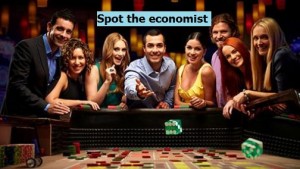Searching for Good Odds
Last week I was in Las Vegas for 48 hours attending a conference. Dear reader, before you smile at this lame attempt to disguise play as work, you should know that I don’t gamble, drink only moderately and do not enjoy loud rock music. Therefore, the sight of yours truly staying at the Hard Rock Hotel and Casino might strike you as incongruous to say the least; I can report that the thumping rock music is as inescapable as the screens of Big Brother in George Orwell’s book 1984. Elevators and bathrooms offered no escape. Fortunately, I was with many friends from Catalyst Funds, our mutual fund partner, and their company made it a thoroughly worthwhile and enjoyable visit. However, as my wife noted, if you’re planning a weekend of alcohol-infused debauchery and gambling, I might not be your best choice of travel companion.
Las Vegas stands for many things; as I walked through the hotel casino full of hopeful slot machine fanatics and blackjack buffs it reminded me that the entire city stands as a testament to a glaring failure of classical economics. In the theoretical world where individuals make rational decisions to maximize their utility, Nevada’s gaming tables with their negative expected outcomes should have no place. The cheerful acknowledgment of punters that the odds favor the house further illustrates how poor are the economist’s tools for explaining the world. One can only square the circle by allowing that the irrational hope of winning big provides positive utility to those relieved of their cash. State-run lotteries work on the same principle, and we non-lottery buyers theoretically pay slightly lower taxes as a result (although that’s hard to believe in New Jersey). The surest way to win is to be a free-rider; the Hard Rock Hotel’s $43 nightly room charge dramatically underprices the facility, because they rely on guests contributing substantially more in the casino. As a stalwart non-participant, I thank my fellow guests for subsidizing my stay. Meanwhile, consider the tormented soul whose $150 “safe” bet on Michigan State to beat Middle Tennessee in the NCAA tournament was lost but would in any case have only paid out $2.15. Let’s at least hope he derived some modest pleasure from temporarily anticipating his winnings. This is someone with a gambling problem.
There have been moments as an MLP investor in recent months when selling out and placing everything on black might have felt more rational and maybe even offered better results. The constant search for good odds in financial markets renders casinos uninteresting, even while MLPs for a while seemed like a faster way to lose money. Fund flows have certainly been an important driver of near term performance, as noted in last week’s post (Up Is The New Black). Figures on MLP fund flows provided recently by JPMorgan were striking, showing that in February $570MM of net inflows came into the sector. This is a substantial show of confidence by retail investors; it more than offset the net outflows ($543MM) that occurred during the entire second half of 2015, during which MLPs sank by 24%. The -0.5% February loss in the Alerian Index masks the substantial intra-month collapse and rebound that the $570MM of inflows helped fuel.
The appetite of retail investors to buy, and then sell, and now buy again MLPs has been a significant factor driving performance. As noted in The 2015 MLP Crash; Why and What’s Next, for a time such investors bridged the gap between MLPs’ need for growth finance and the limited desire of traditional investors to meet it. Direct investors in MLPs who receive K-1s are the quintessential long term investor, not least because time steadily worsens the tax consequences of selling. Retail investors through mutual funds and ETFs are not always so tax-sensitive, and therefore more reactive to recent performance. February’s substantial inflows reflect this shift to more positive sentiment.